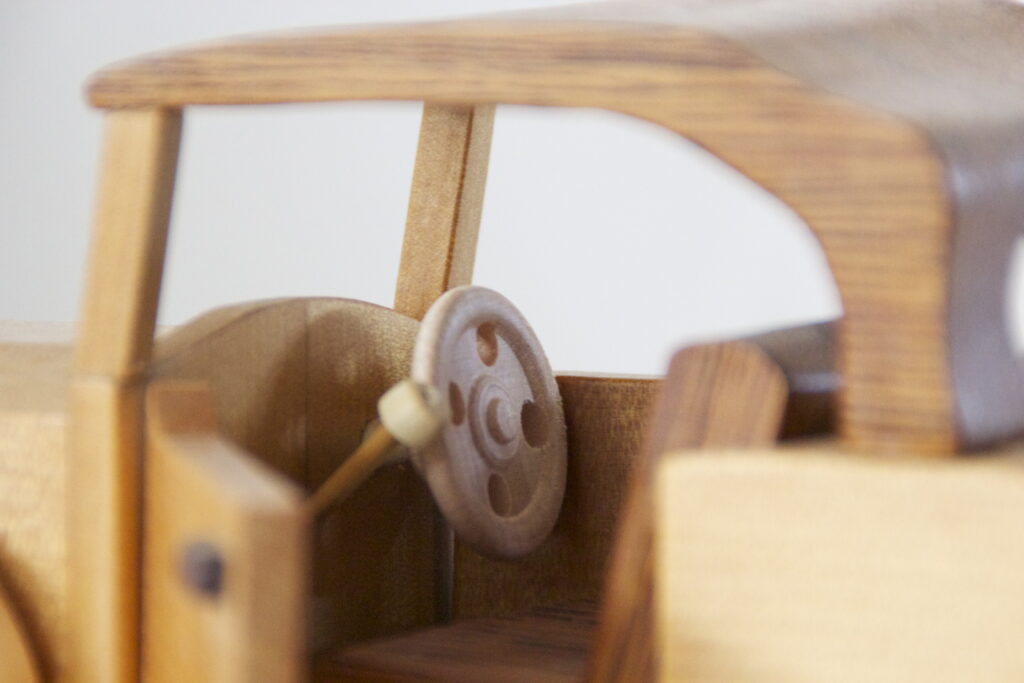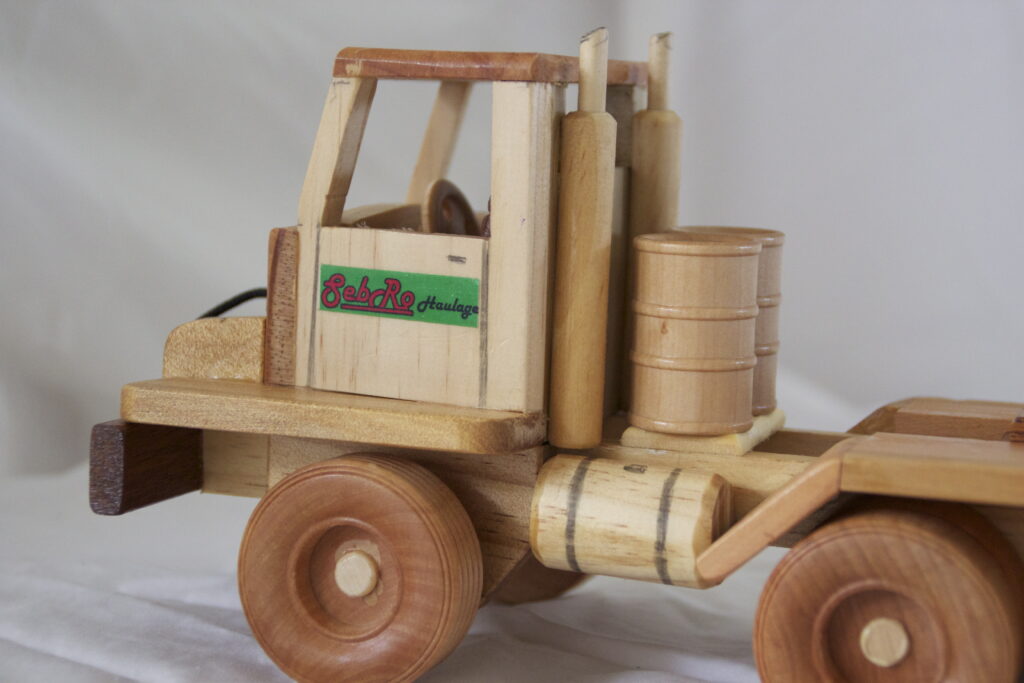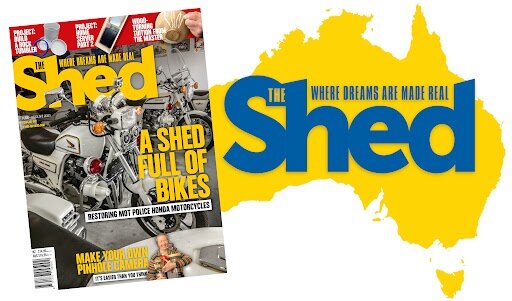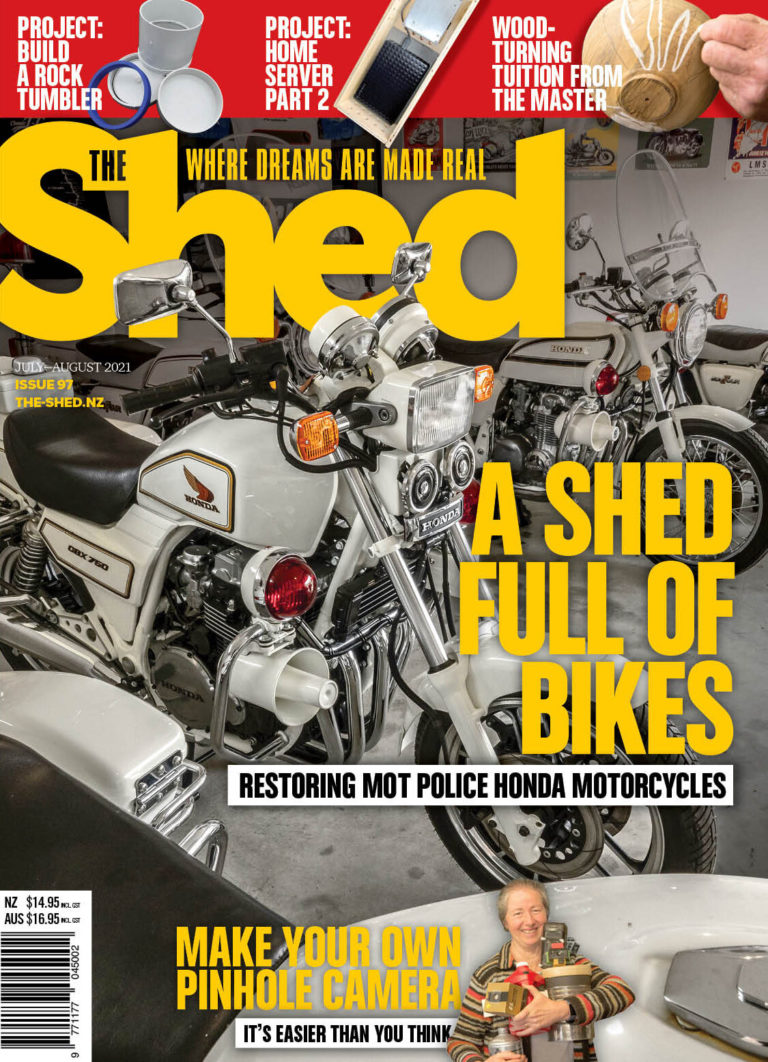Turning to small and delicate
By Stuart Johnston
Photographs: Stuart Johnston

Kaizen is Japanese for a philosophy of continuous improvement, or working methodically seeking to achieve small, incremental changes in the process of improving. This term has been particularly championed by Toyota Motor Corporation as a process to facilitate change within that organisation.
For me, it epitomises my woodworking journey since retirement. I had dabbled in bigger stuff—from building and construction to boat-building (three launches) and fitting out—as sidelines and sanity savers during my years in corporate life.
But when I turned to small and delicate it necessitated a rethink. Thus “kaizen,” which seems to have been driving incremental changes in what and how my projects have evolved.
With the advent of a new “client stream” in three new grandkids, I turned my attention to providing toys and keepsakes for Xmas, birthdays and presents to hopefully provide not only treasures but also an outlet for my changing skills.
With two of the three grandchildren boys, I turned for guidance to books and magazines that provided plans and ideas for puzzles, toys and various other child-centric wooden accoutrements with which to occupy little hands and minds.


First
The first such project, a dump truck in simple form, was taken from Making Wood Trucks & Construction Vehicles by Reg Martin. While I say “simple,” there were some complexities for a new recruit in making the chassis and hoist but not too big a stretch. The outcome was quite satisfying. This project was made entirely of recycled kauri with some kwila for the grille. It is quite a robust construction with brush-finished, water-based floor varnish.
Wanting something that provided some greater challenges, I turned to the book Toys, Games and Puzzles by John A and Joyce C Nelson. After a number of non-vehicle projects, I thought I would build more than one vehicle to perhaps create a market and generate some funds for more native timber and other workshop needs.
So I undertook a production run of six Jeeps from this publication. I started using contrasting timbers, kauri body and rimu wheels. Increased complexity is evident in the mudguards, windscreen and seats. I never did get to sell any and the various kids, family and otherwise who own them have found them to be pretty robust.
From the same book I built three dump trucks. These were to be one each for the boys, but big sister decided that she could play trucks along with her siblings, hence the pink-and-purple version. There is not a great deal of complexity and they are still very robust. But I decided in future to use proprietary wheels as I was not happy with my own results from using circle cutters for this job.
I have used different finishes as well, with vegetable oil on the Jeeps and Haarlem oil on the trucks. Oh, how I love the aroma of Haarlem oils which I find really great for flat surfaces like trinket boxes and the like, but not great for these types of models.



Confidence
By now, I had tried different finishes and with these, and other projects, under my belt I was beginning to gain confidence with my measuring, marking, cutting and finishing. I was starting to have a real appreciation of how native timbers behaved under the saw, sander and differing finishes.
But I had developed a real aversion to making wheels and, having disposed of my lathe because of the mess it generated, I was not keen on acquiring another. Turning to the internet, I found several sources of bits and bobs, wheels and wheel pegs of various types, head and tail lights, steering wheels, dowel, smoke stacks and people for trains, beads, barrels, casks and just about anything else that add to realism in toys and models. (see www.woodcraftparts.com, www.caseyswood.com and www.bearwood.com)
From another couple of books, Making Toys: Heirloom Cars & Trucks in Wood by Sam Martin and Roger Schroeder and Antique Cars & Trucks You Can Make by Luc St-Amour, I produced four Model A pickups, a 1932 Buick from the former and a 1930s Coupe from the latter.
In each case, I made changes which I felt made for more realistic reproductions (including opening doors in the coupe) and felt the proprietary wheels well worth the investment. Both projects were made from recycled native timbers salvaged from old buildings—weatherboards, studs and floor joists mainly—that were begged, gifted or in some cases bought (a six-pack of beer can still work wonders) and acquired over several years.


Native timber
By the time I got to the Buick, I was really looking to make some changes and try to introduce some greater levels of realism. Being the “brave” sheddie that I am, radiata pine (Pinus radiata) became my medium of choice for experimentation; I do not like to waste my precious supply of native timber if there is a chance that my work is not going to work out right.
The only native hard wood that seems to be available from demolitions and the like is rimu and its various hues can make some splendid contrasts with kauri and macrocarpa. Macrocarpa often looks like kauri but has a magnificent aroma and is really nice to work in some situations.
All my models and toys are made from recycled timber of various shapes and sizes, be they pine or natives; most require some cleaning and or de-nailing and, in some cases, paint stripping.
Much painted, recycled timber has used toxic lead paint. I tend to use a heat gun and scraper to remove it and always do in the open air. My 14-inch Carba-Tec bandsaw does sterling work and is by far and away my best and most used and loved tool.
In breaking down slabs, I try to work and process only what I need at any one time. As these woods are so scarce and special, almost every scrap is kept for later use.
Small off-cuts go into two trays on the bench end, one for light-coloured woods and one for dark, while bigger pieces go into a couple of bins beside the saw with intermediate pieces into 300 mm storage cubes alongside.
The small pieces are great for springs, air suspensions, dashboards etc and are always the first port of call. With these disciplines I tend to be a frugal timber consumer.
With that in mind, I decided that pine would make a great “surfer’s woody” and produced five different versions with altered chassis lengths, different seating, one or two sloping or vertical back doors, fuel tanks bumpers etc. The four woody versions all come complete with surfboards. One went to my 16-year-old surfer grandson who just loves it. A couple still sit in the shed as I rather fancy them myself and I believe they look pretty “cool” in pine.


Slab chassis
All of these models/toys have one thing in common: they are constructed from a “slab” chassis. While this helps to make them very robust, they lack any detail below sight-lines and this started me thinking and again looking to the internet for future direction. To keep my interest up while I searched, I tried my hand at developing a model/toy with a more realistic chassis and produced a duo:
- a heavy haulage tractor unit with expanding low-loader semi-trailer, and
- a mine dumper as a load for the semi-trailer.
This was very much a seat-of-the-pants effort starting with the tractor unit and trying to get scale to look right rather than necessarily being “right.” Next, the dumper. It needed to be larger and more bulky than the tractor yet still look proportionately correct to be carried on a low-loader. The dumper has chassis rails along with diffs and drive shafts.
The tractor unit measures 280 mm by 130 mm with 50 mm wheels. The dumper, 380 mm by 160 mm, sits on 75 mm wheels and fits within the expanding low-loader which when extended measures 175 mm wide and 540 mm long riding on 35 mm wheels. Thus the overall vehicle length when tractor and loader are coupled is 725 mm.
These toys are built to be fun and realistic in a young lad’s mind, but they are robust so that they can take a level of “punishment” from kids. I built them virtually entirely of pine but this time they are sprayed with acrylic aerosol varnish. This makes it easier to ensure all parts are covered and treated and brings out the natural wood colours. The downside is the smelly fumes you encounter when using this medium.
My internet searching sent me to some interesting sites and gradually it dawned on me that chassis, leaf or pneumatics springs, shock absorbers, engines gear boxes diffs and even steering front wheels could be built with quite considerable detail.





